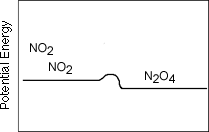Le Chetalier's Principle
- Le Chetalier studied equilibrium systems and determined that: A system in equilibrium will respond to stress in such a way as to counteract that stress.
- There are several ways to stress a chemical equilibrium:
- Add or remove heat: If you add heat the reaction will go in the direction which will use up that heat (convert it to chemical energy). If you remove heat, then the reaction will go in the direction that produces heat (converts chemical to heat energy).
- Add or remove various reactants or products: because reactions occur when molecules collide, adding more of one type of molecule will favor its collision with other molecule, thus increasing the probability that it will react.
- Raise or lower the pressure for reactions which involve gasses: Assuming the reaction vessel remains at a constant volume the only way to respond to increased pressure would be to form fewer moles of gas. Reactions which reduce the number of gaseous molecules would be favored under increased pressure. The opposite is true for reduced pressure.
- Let's consider the following equilibrium reaction:
2 NO2  N2O4
+ energy
N2O4
+ energybrown colorless 
-
As written this reaction is exothermic from left to right and endothermic from right to left.
Molecular animation provided by Molecular Arts Corporation http://www.molecules.com/movies.shtml -
What would happen if you heated this system?
-
What would happen if you increased the pressure on this system?
-
What would happen if you added more N2O4?
-
What would happen if you removed N2O4?
-
What would happen if you added a catalyst?
-